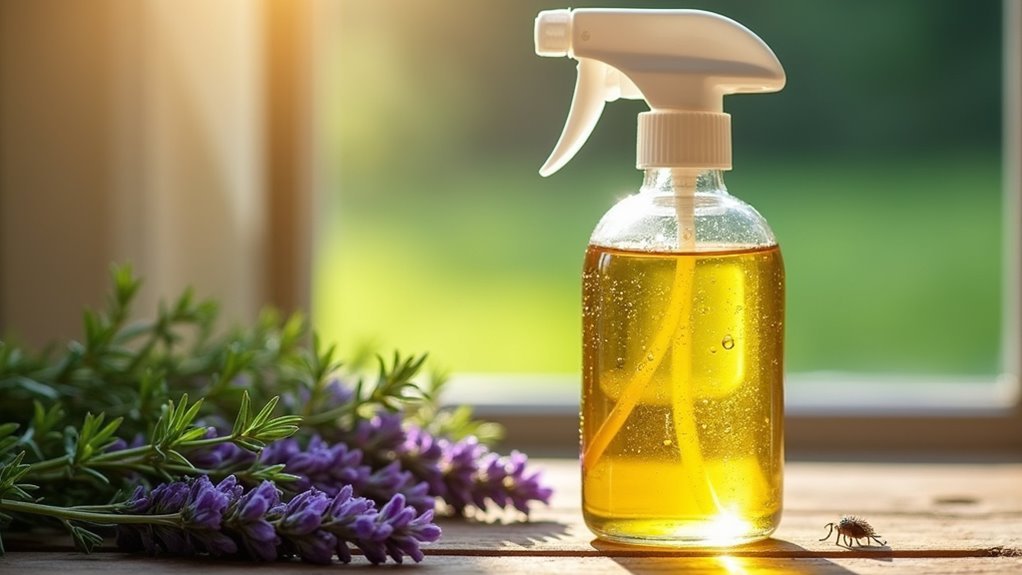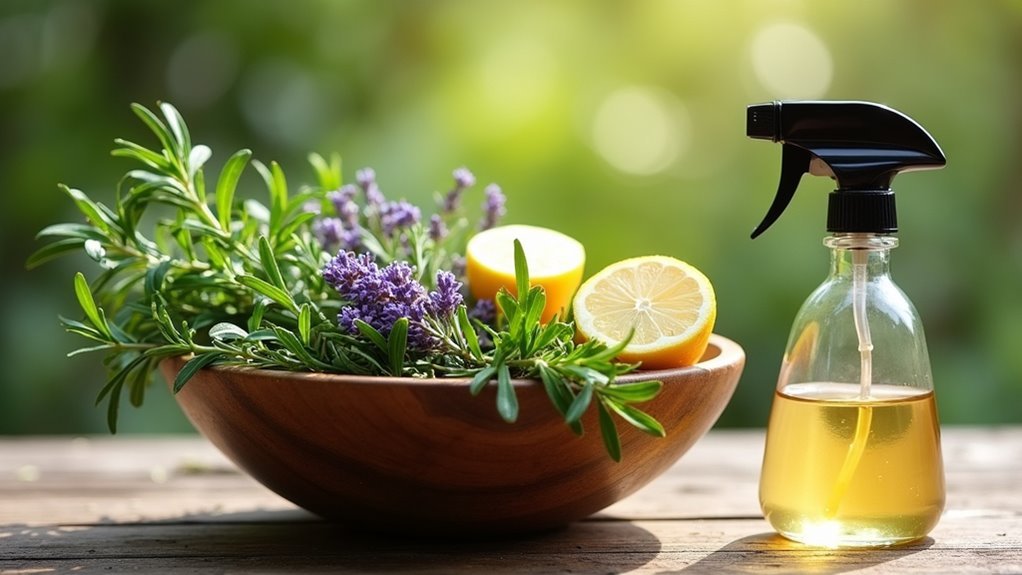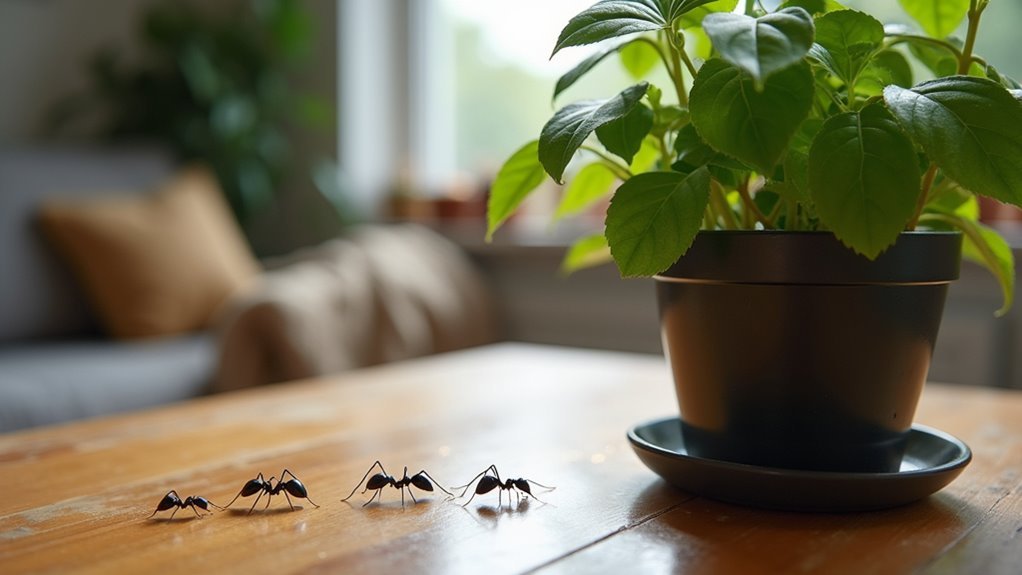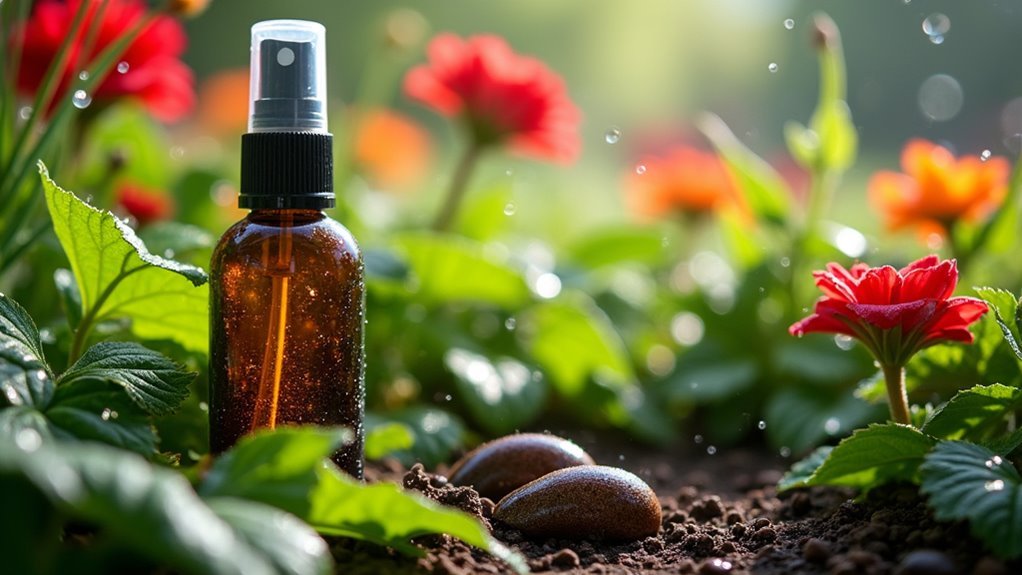You can create an effective tick repellent by mixing equal parts apple cider vinegar and water with 10-20 drops of essential oils like lemon eucalyptus or geranium. The vinegar’s acetic acid disrupts ticks’ sensory receptors, while essential oils enhance protection. Apply every 20-30 minutes to exposed skin, focusing on your neck, scalp, and behind knees where ticks commonly attach. This natural solution offers powerful protection and there’s much more to discover about maximizing its effectiveness.
Understanding Tick Behavior and Risks

Although ticks are tiny arachnids barely visible to the naked eye, they pose a significant health threat by transmitting dangerous diseases like Lyme disease, which affects over 300,000 Americans annually.
You’ll commonly encounter deer ticks, lone star ticks, and American dog ticks in tall grass, wooded areas, and leaf litter where they thrive in warm, humid conditions.
Understanding tick behavior helps with effective natural disease control strategies. Ticks need 36-48 hours of attachment to transmit pathogens, so regular body checks after outdoor exposure become critical.
Regular tick checks within 36 hours of outdoor activity provide your most effective defense against disease transmission.
You won’t notice symptoms for 3-7 days after tick bites occur, making early detection essential. Knowing where ticks lurk and how they operate enables you to protect yourself more effectively when venturing into high-risk environments.
Why Vinegar Works as a Natural Repellent
Vinegar’s potency against ticks stems from its high acetic acid content, which creates a hostile environment these parasites actively avoid.
Apple cider vinegar proves especially effective as a natural repellent because its strong odor and acidic properties disrupt ticks’ sensory receptors, making it nearly impossible for them to locate potential hosts.
Here’s why vinegar works so well to repel ticks:
- Sensory disruption – The acidic nature interferes with ticks’ ability to detect body heat and carbon dioxide
- Hostile environment – Creates an inhospitable surface that ticks won’t land on or crawl across
- Internal protection – When pets consume diluted vinegar, it makes their blood less appealing to parasites
Regular application of vinegar-based solutions maintains tick-free zones around your property and family.
Essential Ingredients for Vinegar-Based Tick Spray

You’ll need just a few key ingredients to create an effective vinegar-based tick repellent that’s both powerful and safe. Apple cider vinegar serves as your main active ingredient because its acetic acid content naturally deters ticks with its strong scent. The basic formula requires equal parts apple cider vinegar and water, creating a balanced solution that’s potent enough to repel insects while remaining gentle on your skin.
Apple Cider Vinegar Benefits
When ticks detect the strong, acidic scent of apple cider vinegar, they’ll typically avoid the area entirely, making ACV one of the most effective natural deterrents available. This powerful natural tick repellent offers multiple benefits that make it superior to chemical alternatives.
The acetic acid in apple cider vinegar works by altering your body’s pH levels, creating an environment that’s inhospitable to ticks and other parasites.
Here’s why ACV stands out as an effective tick repellent:
- Cost-effective protection – ACV costs considerably less than commercial repellents
- Safe for families and pets – This non-toxic alternative eliminates chemical exposure concerns
- Versatile application – You can use it topically as a spray or give diluted amounts to pets internally
This dual-action approach helps repel ticks both externally and internally, providing thorough protection for outdoor activities.
Mixing Ratios and Proportions
Creating an effective vinegar-based tick spray requires precise measurements to balance potency with safety. You’ll want to combine equal parts apple cider vinegar and water for best results. This 1:1 ratio provides strong repellent properties without causing skin irritation.
| Ingredient | Amount |
|---|---|
| Apple Cider Vinegar | 1 part |
| Water | 1 part |
| Essential Oils | 10-20 drops |
| Storage Container | Dark glass spray bottle |
Add 10-20 drops of essential oils directly to your vinegar-water mixture for enhanced protection. Lemon eucalyptus or lavender work exceptionally well. Store everything in a dark glass spray bottle to preserve the oils’ potency. Always shake before using to guarantee proper distribution. Apply the spray every 20-30 minutes for maximum effectiveness.
Step-by-Step Preparation Instructions
Once you’ve gathered your ingredients, start by combining ⅓ cup of distilled water and ¼ cup of witch hazel in a clean glass jar. This mixture creates the perfect base for your homemade tick spray, allowing the essential oils to disperse evenly throughout the solution.
Next, add 30 drops of your chosen essential oils. The most effective combinations include:
- Lemon eucalyptus and geranium for maximum tick deterrence
- Lemongrass and citronella for broad-spectrum protection
- Any combination of all four oils for thorough coverage
Shake the jar vigorously for 30 seconds to confirm proper mixing.
Transfer your DIY recipe into a clean spray bottle using a funnel. Always shake before each use since the oils naturally separate from the water-based solution over time.
Proper Application Techniques and Coverage

You’ll need to target specific body areas where ticks commonly attach, including your neck, scalp, groin, and behind your knees.
Don’t forget to treat your clothing, shoes, and camping gear since ticks can hitchhike on these surfaces before reaching your skin.
Reapply your homemade repellent every 20-30 minutes during peak tick activity or after you’ve been sweating or swimming.
Strategic Body Target Areas
Although ticks can attach anywhere on your body, they prefer warm, moist areas where your skin is thin and blood vessels are close to the surface.
You’ll want to spray your essential oil repellent strategically to prevent bites in these vulnerable areas.
Focus your application on these key zones:
- Behind ears, underarms, and back of knees – These warm, moist spots are tick magnets
- Legs and waistline – Target these areas since ticks crawl up from ground level
- Clothing and shoes – Don’t forget fabric surfaces where ticks often grab hold
Pay special attention to exposed skin areas where ticks can easily attach.
Remember that thorough coverage of these strategic body zones maximizes your repellent’s effectiveness against tick encounters during outdoor activities.
Clothing and Gear Treatment
While treating your skin remains essential, your clothing and gear serve as the first line of defense against ticks crawling up from the ground.
Apply tick repellent thoroughly on all exposed surfaces of your clothing, including boots, pants, and shirts both inside and outside. Focus treatment on critical entry points like cuffs, collars, waistbands, and edges where ticks commonly attach.
Allow treated clothing to dry completely before wearing to guarantee the repellent absorbs properly and remains effective.
Don’t forget your gear – treat tents, backpacks, and other equipment to create extensive protection during outdoor activities.
Always reapply treatment after washing, as laundering reduces effectiveness and compromises your tick barrier.
Reapplication Timing Guidelines
Beyond initial application, maintaining your tick protection requires strategic reapplication timing to keep barriers intact throughout your outdoor adventures.
You’ll need to reapply your homemade tick repellent every 20-30 minutes for maximum protection, especially after sweating or water exposure.
Key reapplication scenarios include:
- After physical activities – Swimming, vigorous exercise, or wiping your skin removes repellent coverage
- Following heavy sweating – Perspiration dilutes the active ingredients on your skin surface
- When switching between indoor and outdoor environments – Temperature changes affect repellent effectiveness
Don’t wait until you feel vulnerable to ticks. Set regular reminders for consistent reapplication throughout your outdoor time.
Focus on maintaining even coverage across all exposed skin areas, paying special attention to previously treated zones that may have worn off during activities.
Safety Guidelines and Precautions
Since natural tick repellents contain concentrated essential oils that can cause skin irritation or allergic reactions, you’ll need to follow specific safety guidelines to protect yourself and your family.
Always dilute essential oils with carrier liquids like witch hazel or distilled water, particularly for children and elderly users. Conduct a patch test on small skin areas before full application to identify potential reactions to natural ingredients.
Avoid applying repellent near eyes, mucous membranes, and broken skin. Store homemade solutions away from children and pets to prevent accidental ingestion.
Reapply every 20-30 minutes during outdoor activities while monitoring for allergic reactions. These precautions guarantee you’ll safely enjoy the benefits of your homemade tick repellent without compromising your family’s wellbeing.
Storage and Shelf Life Considerations
After preparing your homemade tick repellent safely, proper storage becomes your next priority for maintaining its effectiveness.
You’ll want to store your repellent in a cool, dark place to preserve the potency of essential oils and extend its usefulness.
For best results, follow these storage guidelines:
- Use glass containers instead of plastic, as plastic can degrade over time and compromise your essential oils’ quality
- Label your repellent with the preparation date to track freshness within the recommended timeframe
- Discard immediately if you notice separation, color changes, or altered scent
Your natural repellent typically maintains its shelf life for up to one year, depending on specific ingredients and storage conditions.
Natural tick repellents stay effective for up to twelve months when stored properly in cool, dark conditions.
Proper storage guarantees you’re getting maximum protection when you need it most.
Enhancing Effectiveness With Additional Natural Ingredients
While your basic tick repellent provides solid protection, you can greatly boost its effectiveness by incorporating additional natural ingredients that work synergistically with your base formula.
Peppermint and cedarwood essential oils excel at repelling ticks and other insects. Adding witch hazel improves oil dispersion while acting as a natural astringent. Apple cider vinegar not only repels ticks but stabilizes your spray’s ingredients.
Combining multiple essential oils like geranium and lemon eucalyptus creates synergistic effects that increase repellent potency beyond individual oils’ capabilities. These all-natural ingredients work together to enhance effectiveness considerably.
Always test new ingredients for skin sensitivity before full application. Adjust concentrations accordingly to guarantee safety while maximizing your repellent’s protective power against ticks.
Frequently Asked Questions
What Is the Best Homemade Tick Repellent Recipe?
You’ll want to mix ⅓ cup distilled water, ¼ cup witch hazel, and 30 drops of lemon eucalyptus, geranium, lemongrass, or citronella essential oils. Combine everything in a glass jar, then transfer to a spray bottle.
What Is the Strongest Tick Repellent?
You’ll find DEET-based repellents with 30-40% concentration are strongest against ticks. They’ll protect you for several hours. Natural alternatives like 20% oil of lemon eucalyptus work well too, offering comparable effectiveness.
What Is the Best Home Remedy for Ticks?
You’ll find the best home remedy combines lemon eucalyptus, geranium, and citronella oils with witch hazel and distilled water. Mix thirty drops of oils with one-third cup water and quarter-cup witch hazel for effective protection.
Does Vinegar Really Repel Ticks?
Vinegar can repel ticks due to its acidic smell, but you shouldn’t rely on it alone. You’ll get temporary protection when you spray diluted vinegar on clothing, though scientific evidence remains limited.
In Summary
You’ve now got a powerful, natural tick repellent that’s safer than commercial chemicals and costs pennies to make. Remember to reapply every few hours for maximum protection, especially during peak tick season. Store your spray in a cool, dark place and make fresh batches monthly. This vinegar-based solution won’t just keep ticks away—it’ll give you peace of mind when you’re enjoying the outdoors with your family.





Leave a Reply